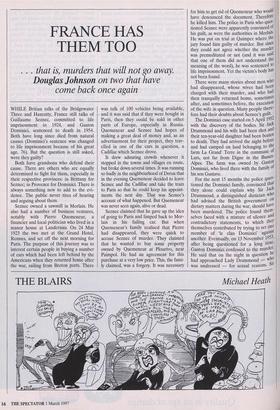FRANCE HAS THEM TOO
. . . that is, murders that will not go away.
Douglas Johnson on two that have
come back once again
WHILE Britian talks of the Bridgewater Three and Hanratty, France still talks of Guillaume Seznec, committed to life imprisonment in 1924, and Gaston Dominici, sentenced to death in 1954. Both have long since died from natural causes (Dominici's sentence was changed to life imprisonment because of his great age, 76). But the question is still asked, were they guilty?
Both have grandsons who defend their cause. There are others who are equally determined to fight for them, especially in their respective provinces: in Brittany for Seznec; in Provence for Dominici. There is always something new to add to the evi- dence. The public never tires of hearing and arguing about them.
Seznec owned a sawmill in Morlaix. He also had a number of business ventures, notably with Pierre Quemeneur, a financier and local politician who lived in a manor house at Landemau. On 24 May 1923 the two met at the Grand Hotel, Rennes, and set off the next morning for Paris. The purpose of this journey was to interest certain people in buying a number of cars which had been left behind by the Americans when they returned home after the war, sailing from Breton ports. There was talk of 100 vehicles being available, and it was said that if they were bought in Paris, then they could be sold in other parts of Europe, especially in Russia. Quemeneur and Seznec had hopes of making a great deal of money and, as an advertisement for their project, they trav- elled in one of the cars in question, a Cadillac which Seznec drove.
It drew admiring crowds whenever it stopped in the towns and villages en route, but broke down several times. It was running so badly in the neighbourhood of Dreux that in the evening Quemeneur decided to leave Seznec and the Cadillac and take the train to Paris so that he could keep his appoint- ments the next day. That was Seznec's account of what happened. But Quemeneur was never seen again, alive or dead.
Seznec claimed that he gave up the idea of going to Paris and limped back to Mor- laix in his failing car. But when Quemeneur's family realised that Pierre had disappeared, they were quick to accuse Seznec of murder. They claimed that he wanted to buy some property owned by Quemeneur at Plourivo, near Paimpol. He had an agreement for this purchase at a very low price. This, the fami- ly claimed, was a forgery. It was necessary for him to get rid of Quemeneur who would have denounced the document. Therefore he killed him. The police in Paris who qua' tioned Seznec were apparently convinced of his guilt, as were the authorities in Morlaix He was put on trial at Quimper where the jury found him guilty of murder. But since they could not agree whether the murder was premeditated or not (and it was said that one of them did not understand the meaning of the word), he was sentenced to life imprisonment. Yet the victim's body has not been found.
There were many stories about men who had disappeared, whose wives had been charged with their murder, and who had then tranquilly returned home, sometimes after, and sometimes before, the execution of the wife in question. Many people there- fore had their doubts about Seznec's guilt. The Dominici case started on 5 April 1952 with the discovery of the bodies. Sir Jack Drummond and his wife had been shot and their ten-year-old daughter had been beaten to death. They had arrived the night before and had camped on land belonging to the farm La Grand' Terre in the commune of Lurs, not far from Digne in the Basses- Alpes. The farm was owned by Gaston Dominici, who lived there with the familY of his son Gustave.
For the next 15 months the police ques- tioned the Dominici family, convinced that they alone could explain why Sir Jack Drummond, a distinguished dietician who had advised the British government on dietary matters during the war, should have been murdered. The police found them- selves faced with a mixture of silence and contradictory statements, to which they themselves contributed by trying to set one member of 'le clan Dominici' against another. Eventually, on 13 November 1953, after being questioned for a long time, Gaston Dominici confessed to the murder. He said that on the night in question he had approached Lady Drummond — who was undressed — for sexual reasons. Sir Jack interrupted them and it was then that Dominici had killed all three of the campers. 'I didn't know what I was doing,' was his conclusion. As soon as Dominici had made this con- fession, he changed his mind and denied it. Nevertheless he was tried in Digne a year later and found guilty, without attenuating circumstances. Although enquiries were launched from Paris, and at least two min- isters declared an interest in the affair (including Francois Mitterrand), there was no change in the verdict. But Dominici's personal position was dramatically trans- formed after a 1960 television programme showing the old man in the prison of Les Baumettes at Marseilles. He declared him- self innocent and revealed something of his unhappiness at being far from his farm and separated from his dog. Among the spectators was General de Gaulle. Moved by emotion and sympathy, he pardoned Dorninici on 13 July 1960, But, as certain French individuals, along with the British newspapers, pointed out, a ten-year-old girl had been murdered and was buried in the cemetery of Forcalquier, near Lurs. It is most unlikely that de Gaulle ever said, as it was recounted, `Pah! Dominici only killed some English people.' The rumour existed that Drummond had been killed by a German because he was in the process of analysing the dietetic experi- ments which the Nazis had carried out on Jews, gypsies and other 'inferior beings'. Drummond had been targeted to prevent publication of the details of this Nazi crime. De Gaulle could not reveal this, but he could and did set an innocent man free.
A French writer has very recently cor- rected this story. William Raymond, using American and German documents, claims that the murder had been organised by a German, Wilhelm Bartkowski, who had confessed to it in November 1952. Drum- mond was a member of the intelligence service and was engaged, on behalf of the British and American governments, in recruiting German scientists who had worked for the Nazis. The Soviet riposte to this was to organise the killing of cer- tain of the scientists and of Drummond, a well-informed agent. The German govern- ment communicated details of Bartkows- Id's confession to the French, but they decided to do nothing about it.
Seznec was pardoned with the Libera- tion. He returned to France from prison in the Cayennes in 1947 and worked hard to get his condemnation quashed. He failed, and died in 1954. But Seznec's grandson received, at the end of last year, three pho- tographs which had been found among the belongings of a Breton gendarme. They showed Quemeneur's property at Plourivo, where the gendarmes had been digging in 1953, and in particular they revealed that a skull had been unearthed. Were these the remains of Quemeneur? If so, this would almost certainly mean that Seznec had not killed him. Lawyers employed by Seznec's grandson enquired if there were records describing the digging operations of 1953. Eventually, they were informed that these records had been destroyed by the fire in the Parlement de Bretagne at Rennes, in 1994. The suggestion is that Quemeneur's activities, including the sale of American vehicles in Europe (including Russia), were only part of a larger operation involving French government officials. Hence the need to condemn Seznec, and then to keep quiet about it afterwards. Do we explain these two cases in terms of police and judicial incompetence? Or were innocent men condemned for raison d'etat? In France, Captain Dreyfus still casts a long shadow.



























































 Previous page
Previous page